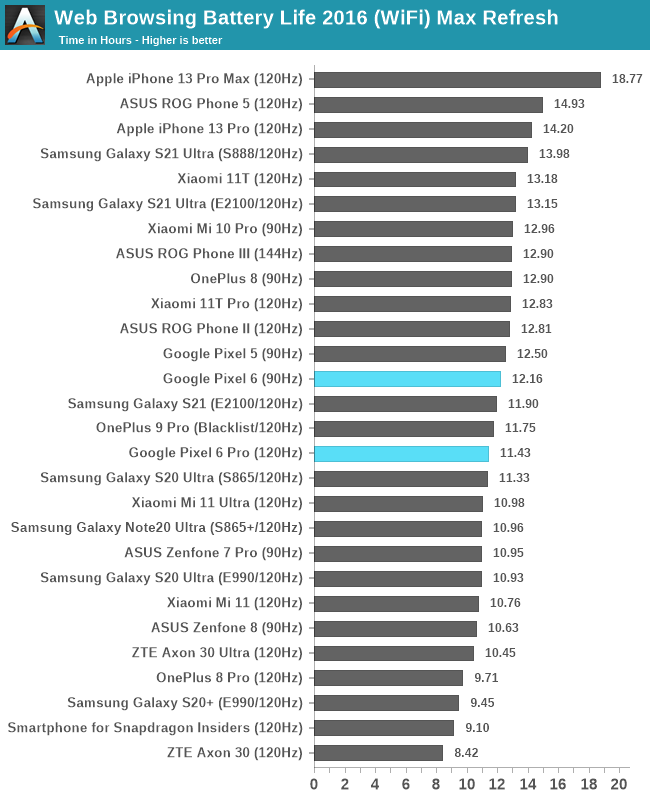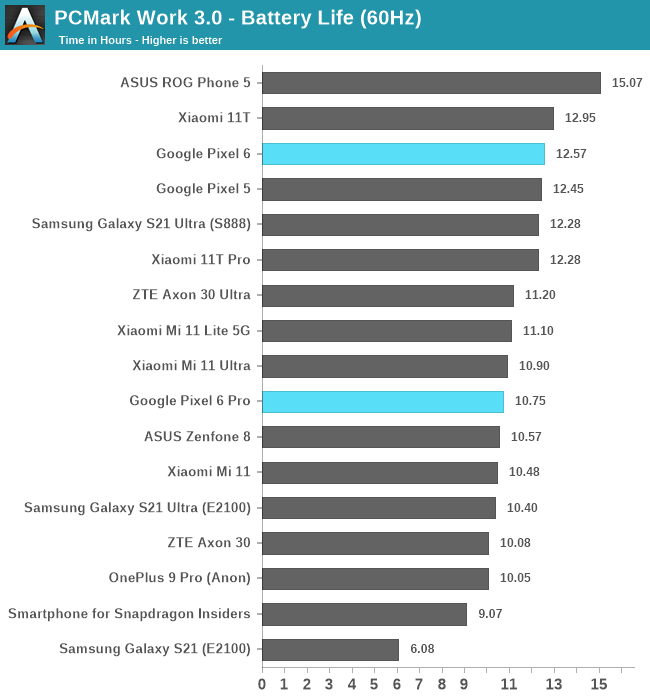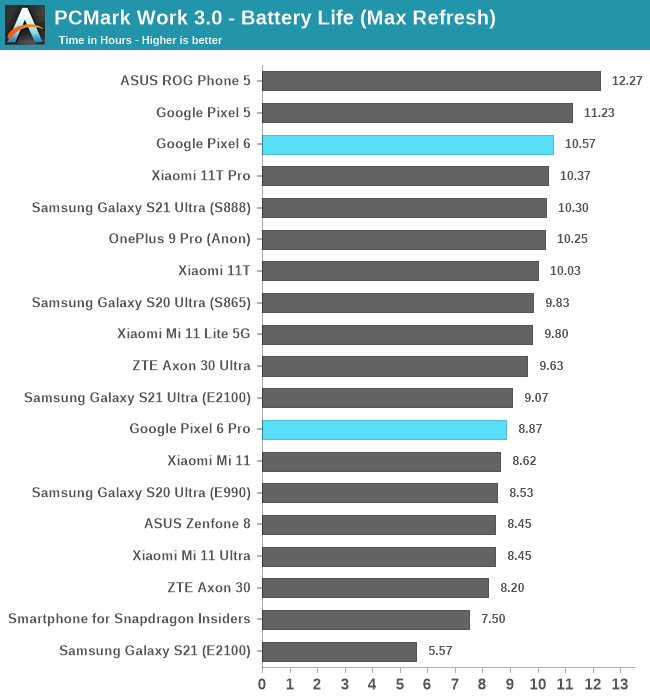Google's Tensor inside of Pixel 6, Pixel 6 Pro: A Look into Performance & Efficiency
by Andrei Frumusanu on November 2, 2021 8:00 AM EST- Posted in
- Mobile
- Smartphones
- SoCs
- Pixel 6
- Pixel 6 Pro
- Google Tensor
Phone Efficiency & Battery Life
While not directly released to the Google Tensor, I also finished running the various battery tests for the Pixel 6 and Pixel 6 Pro, and there are some remarks to be made in regards to the power efficiency of the devices, and how the new SoC ends up in relation to the competition.
As a reminder, the Pixel 6 comes with a 4614mAh battery and a 6.4” 1080p 90Hz OLED screen, while the Pixel 6 Pro features a 5003mAh battery and a 6.71” 1440p 120Hz OLED display, with variable refresh rate from 10-120Hz.

Starting off with the 60Hz web browsing results, both Pixel phones end up extremely similar in their longevity, at 14 hours runtime. The regular Pixel 6 is hard to compare things to as we don’t have too many recent phones with 90Hz displays in our results set, however the Pixel 6 Pro should be a direct comparison point to the S21 Ultras, as both feature 5000mAh batteries and similar display characteristics. The P6Pro here ends up slightly ahead of the Exynos 2100 S21 Ultra, which might not be too surprising given that the Tensor chip does end up at somewhat lower CPU power levels, even if performance is lower. It’s still quite behind the Snapdragon 888 variant of the S21 Ultra – which is again quite representative of the SoC efficiency differences.

Running the phones at their respective max refresh rates, both devices see larger drops, however the Pixel 6 Pro especially sees a more substantial hit. This time around, the 6 Pro ends up significantly behind the Exynos 2100 S21 Ultra, which had only a minor drop in the 60 -> 120Hz results.

Shifting over to PCMark at 60Hz, we see that there’s a larger difference in favour of the Pixel 6, as the Pixel 6 Pro ends up behind it in longevity by almost two hours. The 6 Pro still ends up in line with the E2100 S21U, however that device showcases significantly higher performance numbers in the test, which acts both as a performance metric for device responsivity as well as a battery life test.

At 120Hz, the 6 Pro ends up worse than the E2100 S21U, and quite worse than the S888 S21U.
When I was investigating the phones, the 6 Pro’s power behaviour was quite weird to me, as I saw best-case baseline power figures of around 640mW, and sometimes this inexplicably would also end up at 774mW or even higher. What this reminded me of, was the power behaviour of the OnePlus 9 Pro, which also suffered from extremely high baseline power figures. Both the 6 Pro and the 9 Pro advertise themselves as having LPTO OLED panels, but both of them very clearly do not behave the same as what we’ve seen on the Note20Ultra or the S21Ultra phones. The 6 Pro also only goes up to up to 750 nits 100% APL peak brightness in auto-brightness mode under bright ambient light, which is significantly lower than the S21U’s 942 nits. I think what’s happening here is that the Pixel 6 Pro simply doesn’t have the most state-of-the-art display, and thus is quite less efficient as what we find on the competition. It does kind of make sense for the price-point of the phone, but also explains some of the battery behaviour.
Naturally, the Tensor SoC also just doesn’t appear to be as efficient. Particularly many UI workloads would be run on the A76 cores of the chip, which just outright have a 30% perf/W disadvantage. The phone ends up OK in terms of absolute battery life, however performance metrics are lower than other devices.
I think the regular Pixel 6 here is just a much better device as it doesn’t seem to have any particular issues in display efficiency, even if it’s just a 1080 90Hz panel. There are naturally experience compromises, but it’s also a $599 phone, so the value here is very good.
US readers who are used to Qualcomm phones might also encounter efficiency regressions when under cellular data – we abandoned doing testing here many years ago due to the impossible task to get consistent test environments.










108 Comments
View All Comments
sharath.naik - Thursday, November 4, 2021 - link
Good in-depth review. I know you are doing the camera review of this. So I have a request can you look into if the Pixel 6 cameras are hardware binned to ~12MP even though the specs say they are 50MP/48MP. There is a lot of mixed views out there, most mistaking this as the pixel binning done on other phones like galaxy S21u(Software binned for low light but has access to full resolution). If you could confirm this for the review would be great, looking forward to that review.Silver5urfer - Tuesday, November 2, 2021 - link
Exactly as expected 1:1The SoC is a bust, they tried to do some gimmickry with their zero talent and tried to make it a cheaper deal by going to Samsung for their IP fabrication expertise and lithography process. Ended up being a dud in CPU, GPU and price to performance, all that NPU NN, mega magic boom is all a farce. I was asking the same thing, what does these provide to us end users ? Nothing. Just that fancy Livetranslation and other gimmicks which you use seldom. On top we do not even know what TPU does in the Pixel Software, it's closed source. AOSP is open but Pixel UI and all backend are closed.
Hardware is utter joke, the P6 series has garbage mmwave system look at the internals, they crammed one lol. LG V50 back in 2019 had 2-33 mmwave antennas. This junk saved on cost. The display has banding issues all over the place. Optical image sensor for Fingerprint is slow and a joke vs the physical dedicated ones. The stereo speaker system has massive channel imbalance on top. Then you have the low battery SoT for this price point and battery capacity. The DIY aspect is thrown into gutters, the phone has massively hamfisted cooling approach with graphite pads smeared all over the place as leaks showed and no proper HS system it's just a small pathetic AL board reinforcement plate doing it so on top the Display has no metal backplate to reinforce it or dissipate heat. What a nonsense. SD888 itself heats up a lot and so many vendors add VC cooling, Sony Xperia 1 Mark 3 messed up there and had inferior performance with throttling. This junk is even more pathetic, pay for a S tier SKU get trash sustained performance of a B+ device, the AP, Pocket now and other Youtube shill press will hype this to moon.
We do not even know how this junk has in terms of Software blocks like P2, P3, P4 had A/B system, then merged partitions, later read only ext4 system. This will have even worse. To make it a round about trash, the software is a joke cheap kiddo inspired garbage, heck that BBKs OnePlus's Oxygen + Oppo Color OS mix is way superior than this junk with massive information density loss.
I'd wait for the next SD successor device, hopefully 888's BS power consumption and insane heat can be reduced.
Silver5urfer - Tuesday, November 2, 2021 - link
It's a typo for mmwave, it's 2-3 units. Also I forgot to mention the lack of charger, SD slot, no 3.5mm jack very poor servicing almost impossible to get the phone properly cooled if you open it due to cheap graphite pad reliance. It also has that USB port and microphone soldered to the mainboard which looks like a feeble trash unit check any phone in the recent times and look how solid engineered they are, dual sandwich designs with reinforced chassis and proper heat dissipation.goatfajitas - Tuesday, November 2, 2021 - link
People get WAY too hung up on benchmarks. LOL, a "dud". A phone is about user experience, not how many "geekmarks" = best.lionking80 - Tuesday, November 2, 2021 - link
I agree that the benchmarks do not tell the whole story, but I would still say that even the use of a Snapdragon 870 would have been a better choice.The general performance is similar (maybe a small advantage for Tensor in AI), but the advantages of Snapdragon 870 are bigger: runs much cooler, hugely better battery-life.
To be honest I am disappointed by the SOC. The only thing that might make it a seller is the software (ui and camera), but the SOC is rather a no-go.
goatfajitas - Tuesday, November 2, 2021 - link
There are other factors though. Early ROM settings, tweaks, bugs, and cooling/hardware. The 870 may have scored lower in a P6 as well. So many factors. - Agreed, the P6 should be a bit more polished though.at_clucks - Tuesday, November 2, 2021 - link
The problem goes beyond the slightly worse SoC than the already existing Qualcomm offering. It's that despite being a "Google SoC" they still support it for just 3 years. All the excuses used over the years, all the pointing fingers at SoC manufacturers for the lack of support were just proven to be a load of crap. Same crap, now with a google sticker.sharath.naik - Tuesday, November 2, 2021 - link
It's about to get worse with the camera review. I can verify Google might have been bluffing about the 50mp/48mp sensors. The sensors are locked at 12mp. So Pixel pro has essentially three 12 mp cameras. Which means the portrait mode zoom of 2x is a low resolution 3 MP image. Also at 10x zoom the image resolution is 2.5MP, 4 times lower than that of s21 ultra. What drove Google to make the choice of first hardware pixel binning the resolution down and then trying to digitally blow the resolution backup!!.It's baffling, tried to get an answer from Google support, they just refused to confirm or deny this is binned at the hardware levelhoxha_red - Tuesday, November 2, 2021 - link
"I can verify that google might have been bluffing"dude, lmfao—it's called "binning"; please look it up. they've been upfront about this and it was known before the phone was even launched, let alone after we've seen all of these reviews. The reason Google support "refused to confirm or deny" is because the people doing customer support are unlikely to know what "pixel binning" is (hey, I guess they're in good company there with you), and are not equipped to deal with weirdos of your specific variety.
Maxpower27 - Tuesday, November 2, 2021 - link
You obviously have no familiarity with mobile phone cameras and sensors in particular. Read up about them and then try again.